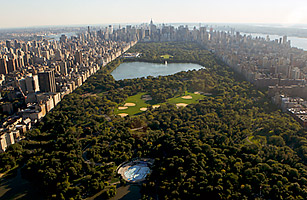
What’s the greenest place in America? If you answered something like the granola-crunchy, Rocky Mountain-high town of Boulder, you’d be wrong. If you guessed the sea breezes and warm sunlight of Santa Barbara, you’d be wrong again. The greenest place in America is almost devoid of nature — the buildings outnumber the trees — and the air isn’t all that great. But what it has is density and efficiency — the twin qualities that ultimately define green in the global warming era. Applying those standards, the greenest place in America is New York City — specifically, the overcrowded, overpriced and sometimes overwrought island of Manhattan, which has a per-capita greenhouse gas footprint less than 30% that of the national average.
It’s that density — the sheer number of people living in such a small area, often literally on top of each other — that makes Manhattan, and New York City as a whole, so green. Manhattan’s population density is 800 times the national average. Density comes with negatives, certainly — small living spaces, air pollution, lots and lots of concrete — but it also enables amazing efficiencies. More than 80% of Manhattanites travel to work by public transit, by bike or on foot — compared to an average of about 8% everywhere else in the country. The vertical apartment buildings that Manhattanites live in are far more energy-efficient than single-dwelling housing in the suburbs. “Most Americans, including most New Yorkers, think of New York City as an ecological nightmare, a wasteland of concrete and garbage and diesel fumes and traffic jams,” wrote David Owen in his 2009 book Green Metropolis. “But in comparison with the rest of America it’s a model of environmental responsibility.”
What’s true of New York City is true of other American urban areas, albeit to a lesser degree, which is why a growing part of the environmental movement now focuses on greening cities, with the hope of attracting more Americans back downtown and reversing suburban flight. That was the message at the Garrison Institute’s Climate, Cities and Behavior conference in New York’s Hudson Valley last week, which brought together urban managers from around the country to brainstorm on sustainability. From deep-green capitals like Portland to unexpected success stories like Minneapolis , there’s an effort to make cities more sustainable, by improving public transit, reducing air pollution and upgrading energy efficiency. But even more important, there’s a much-needed push underway to reverse decades of government policies that have been weighted against cities in favor of the suburbs, with disastrous consequences for energy, the environment and the climate.
Even without such a coordinated effort, there’s plenty of local urban greening going on. Vancouver — with its new LEED Platinum convention center and its gorgeous downtown — has been able to reduce greenhouse gas emissions 6% below 1990 levels, even as the city’s population and economy have grown. Sadhu Johnston, Vancouver’s deputy manager — and the former chief environmental officer for Chicago — pointed out that the city has convinced some 60,000 people to move downtown, thanks largely to better quality of life. Minneapolis has raised the number of bike commuters — no small thing in a part of the country with such punishing winters — by improving safety and service. San Francisco now diverts 77% of its waste from landfills — including organic waste through composting — and officials believe the city can recycle as much as 90% of the waste stream. “We can effect change by designing better communities,” Johnston told the audience at the Garrison meeting.
That’s exactly the challenge. For all the emphasis on improving lighting efficiency in city buildings, or pushing for less wasteful boilers in apartment buildings, for all the convenience and richness of living in a city, there are downsides too — and they can be big ones. New York, for instance, has some of the highest childhood asthma rates in the U.S., a fact that is exacerbated by its tightly packed population and the sheer amount of energy — mostly in the form of fossil fuels — being burned in a small area. As Owen points out in a book, on a per-capita basis Manhattan is an environmental utopia, but on a per sq. ft basis it can still be an environmental catastrophe. Air pollution contributes to approximately 6% of the deaths in the city each year, along with more than 6,000 emergency department visits for children and adults annually.
So it’s welcome news that New York under Mayor Michael Bloomberg has continued to push its PlaNYC scheme, an innovative long-term program to make the city greener and more sustainable over the next couple of decades. Last month Bloomberg announced an update to the plan that includes the phasing out of heavy heating oils in New York City apartment buildings. Soot from the 10,000 or so buildings burning heavy heating oils accounts for more than 85% of the heating oil soot emissions in the city — more than all the soot created by New York’s cars and trucks combined. The rules will phase out the worst heating oils by 2030, to be replaced chiefly with cleaner natural gas. “By the time today’s new rules are fully implemented, we expect that they will save something like 1,500 New Yorkers’ lives each year and improve the quality of life for thousands more,” Bloomberg said.